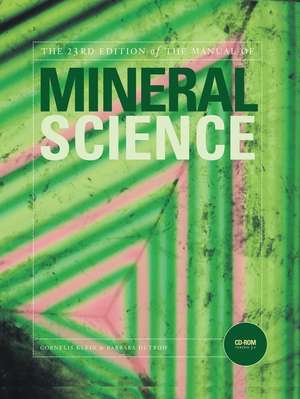Manual of Mineral Science 23e
Autor C Kleinen Limba Engleză Hardback – 30 aug 2007
This new edition contains 22 chapters, instead of 14 as in the prior edition. This is the result of having packaged coherent subject matter into smaller, more easily accessible units. Each chapter has a new and expanded introductory statement, which gives the user a quick overview of what is to come. Just before these introductions, each chapter features a new illustration that highlights some aspect of the subject in that particular chapter. All such changes make the text more readable, user-friendly and searchable. Many of the first 14 chapters are reasonably independent of each other, allowing for great flexibility in an instructor's preferred subject sequence. The majority of illustrations in this edition were re-rendered and/or redesigned and many new photographs, mainly of mineral specimens, were added.
NEW Thoroughly Revised Lab Manual ISBN13: 978-0-471-77277-4
Also published by John Wiley & Sons, the thoroughly updated Laboratory Manual: Minerals and Rocks: Exercises in Crystal and Mineral Chemistry, Crystallography, X-ray Powder Diffraction, Mineral and Rock Identification, and Ore Mineralogy, 3e, is for use in the mineralogy laboratory and covers the subject matter in the same sequence as the Manual of Mineral Science, 23e.
Preț: 1188.66 lei
Preț vechi: 1997.15 lei
-40% Nou
227.46€ • 243.22$ • 189.64£
Carte indisponibilă temporar
Specificații
ISBN-10: 0471721573
Pagini: 704
Dimensiuni: 219 x 282 x 32 mm
Greutate: 1.6 kg
Ediția:23rd Edition
Editura: Wiley
Locul publicării:Hoboken, United States
Public țintă
Geologists, mineralogists, amateur collectorsNotă biografică
James D. Dana (1813 - 1895) graduated from Yale University in 1833. He joined a U.S. exploring expedition to the South Seas (1838 - 42), acting as a geologist and zoologist. His contributions to the American Journal of Science stimulated U.S. geologic inquiry. His research into the formation of the Earth's continents and oceans led him to believe in the progressive evolution of the Earth's physical features over time. By the end of his life he also came to accept the evolution of living things, as articulated by Charles Darwin. During his lifetime, and largely under his leadership, U.S. geology grew from a collection and classification of unrelated facts into a mature science.
